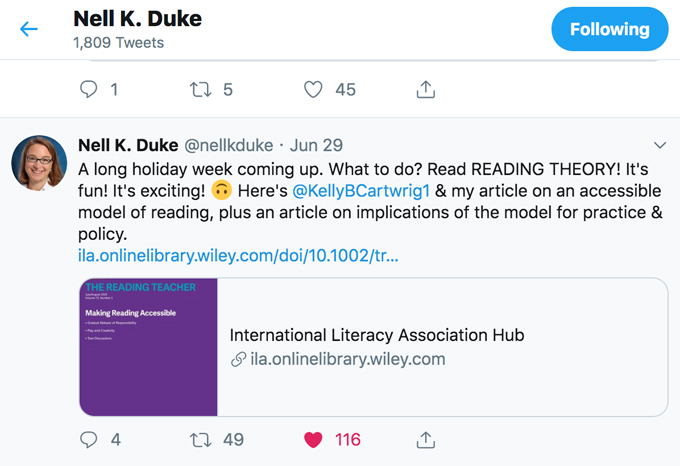 Take a moment to reflect on your daily digital reading habits. How do you start your day? Perhaps you begin the morning by reviewing your Google Calendar to see what the day ahead entails, then catch up on the latest news from AllSides, next you read the latest education news curated from Troy Hick’s Nuzzel newsletter, and then spend a few minutes scrolling through your Twitter feed and notice an article highlighted by Nell Duke that you like and will read later. Within the first hour of waking, many of us have immersed ourselves in a significant amount of online reading, most of which is informational in nature.
Take a moment to reflect on your daily digital reading habits. How do you start your day? Perhaps you begin the morning by reviewing your Google Calendar to see what the day ahead entails, then catch up on the latest news from AllSides, next you read the latest education news curated from Troy Hick’s Nuzzel newsletter, and then spend a few minutes scrolling through your Twitter feed and notice an article highlighted by Nell Duke that you like and will read later. Within the first hour of waking, many of us have immersed ourselves in a significant amount of online reading, most of which is informational in nature.
Regardless of our online reading habits, the “internet of things” doesn’t sleep and will continue to soar in the variety of information being generated through the datafication of online clicks, likes, shares, postings, streamings, and more. The diverse reading that we—and our students—will have to traverse online requires that we have skills and strategies to navigate and comprehend the various multimedia elements in genre-bending spaces.
It’s clear informational reading plays a significant role in our readerly lives yet early learners often have limited access and exposure to informational text in school. What can we do to help prepare our students to comprehend informational text in a digital environment?
Adapting and extending research
Bridget Dalton and C. Patrick Proctor’s research suggests that text-based pedagogical strategies, such as reciprocal teaching, can help support students’ thinking when extended to a digital literacy environment. Moving reciprocal teaching into an online environment involves supported instruction around the adapted use of four comprehension strategies—predict, question, clarify, summarize—and has text-based research for improving reading comprehension.
In an adapted version of reciprocal teaching, an upper elementary student from Michigan created several short metacognitive screencasts to demonstrate the strategic reading of online informational text in a digital learning environment.
Reciprocal teaching screencasts
Note that other digital tools, such as InsertLearning or DocHub, could be used to make digital annotations viewed in the screencast clips above.
Although this tailored version of reciprocal teaching took place in a static digital space, it still beautifully captures how online tools can be leveraged to better navigate and comprehend online information. After receiving explicit, direct instruction, this student demonstrates how using the strategies—making predictions, clarifying thinking while reading, and using questioning to set authentic purposes for reading—can strengthen comprehension. In addition, the digital think-aloud clips of the strategy itself amplify the student’s learning within the digital environment.
Implications for text-based strategies
We can move students from effortful strategy use to a more automatic skill by intentionally introducing them to a repertoire of impactful strategies that will help them monitor their understanding of online informational text. As the information at our fingertips continues to soar, increased action research and scholarship exploring the successes and/or failures of proven text-based strategies in digital environments will be highly beneficial for classroom teachers and their students.
Amber White is a reading specialist, a teacher consultant for the Saginaw Bay Writing Project, and the Director of Curriculum and Instruction for North Branch Area Schools. You can reach her on Twitter @AWhite100.
This article is part of a series from the International Literacy Association Technology in Literacy Education Special Interest Group (TILE-SIG).